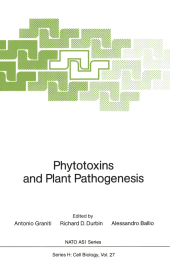 Neuerscheinungen 2012Stand: 2020-01-07 |
Schnellsuche
ISBN/Stichwort/Autor
|
Herderstraße 10
10625 Berlin
Tel.: 030 315 714 16
Fax 030 315 714 14
info@buchspektrum.de |

Alessandro Ballio, Richard D. Durbin, Antonio Graniti
(Beteiligte)
Phytotoxins and Plant Pathogenesis
Herausgegeben von Graniti, Antonio; Durbin, Richard D.; Ballio, Alessandro
Softcover reprint of the original 1st ed. 1989. 2012. xv, 508 S. XV, 508 pp. 76 figs. 242 mm
Verlag/Jahr: SPRINGER, BERLIN 2012
ISBN: 3-642-73180-5 (3642731805)
Neue ISBN: 978-3-642-73180-8 (9783642731808)
Preis und Lieferzeit: Bitte klicken
Proceedings of the NATO Advanced Research Workshop on Phytotoxins and Plant Pathogenesis held at Capri, Italy, May 30 - June 3, 1988
´Session I - Structure and Some Biological Aspects of Phytotoxins.- 1. Current research into chemical synthesis of phaseolotoxin.- 2. Structural studies on host-specific phytotoxins in corn blight and citrus brown spot disease.- 3. Biosynthesis and regulation of toxins produced by Pseudomonas syringae pv. glyci nea (coronatine) and Pseudomonas andropogonis (rhizobiotoxine).- 4. Biological activities of structural variants of host-selective toxins from Cochliobolus victoriae.- Session 2 - Genetic Aspects of Toxin Production.- 1. Genetic analysis of toxin production in fungi.- 2. Identification and isolation of a DNA region required for tabtoxin production: apparent deletion in Pseudomonas syringae pv. tabaci variant ´angulata´ and tox- mutants.- 3. Ornithine carbamoyl transferase gene duplication and phaseolotoxin resistance in Pseudomonas syringae pv. phaseolicola.- 4. Cloning and characterization of genes encoding phaseolotoxin, the toxin produced by Pseudomonas syri ngae pv. phaseolicola.- 5. A novel toxin produced by Pseudomonas corrugata, the causal agent of tomato pith necrosis: determination of its role in virulence and the genetics of production.- 6. Mode and physiological consequence of AAL-toxin interaction with the asc locus in tomato.- Session 3 - Mode of Action of Phytotoxins and Effects on Plants.- 1. Fusicoccin-receptor interaction and activation of plasma membrane H+-ATPase in native membrane vesicles.- 2. Action of fusicoccin in vivo: physiological and biochemical consequences.- 3. Mode of action of fusicoccin: the role of specific receptors.- 4. Interactions of Phytotoxins with plant cell membranes: electrophysiology and ion flux-induced pH changes.- 5. Syringomycin effects on plasma membrane Ca+2 transport.- 6. Extracellular polysaccharides as determinants of leaf spot diseases caused by pseudomonads and xanthomonads.- 7. Development of the chlorotic symptom caused by tabtoxin.- 8. Maize mithocondria Fl-ATPase inhibition by the Cochliobolus heterostrophus race T - toxin and methomyl.- Session 4 - Ecological Aspects and Applications of Phytotoxins.- 1. Host recognition: can accessibility to fungal invasion be induced by host-specific toxins without necessitating necrotic cell death?.- 2. Toxins and disease resistance.- 3. Plant cell death: a determinant of disease resistance and susceptibility.- 4. Ecological consequences of toxin production by Cochliobolus and related fungi.- 5. A promising strategy for the control of fungal diseases by the use of toxin-degrading microbes.- 6. Fungal Phytotoxins - potential new herbicides.- 7. Possible applications of Phytotoxins.- Summaries of Posters.- 1. Immunoaffinity chromatography of endogenous ligands for fusicoccin binding sites.- 2. Structure of syringomycin. A progress report.- 3. Occurrence of multiple forms of syringomycin.- 4. Structural studies of syringomycin.- 5. Toxins produced by three species of Seiridium affecting cypress trees.- 6. Production of cytochalasins by isolates of Ascochyta heteromorpha from oleander and negative evidence for their role in leaf spot disease.- 7. Structural studies on the Phytotoxins produced by a pathotype of Alternaria citri causing a brown spot disease of mandarins.- 8. Molecular features affecting the biological activity of the host-selective toxins from Cochliobolus victoriae.- 9. Isolation and properties of two toxins from culture filtrates of Ascochyta rabiei.- 10. Leaf spotting toxins from Septoria nodorum.- 11 Hypoxylon mammatum toxins. Their nature and their role in host parasite relationships.- 12. Properties of a high molecular weight toxin produced by Phytophthora drechsleri f. sp. cajani inculture.- 13. Production of antraquinone derivatives by Phoma trachei phi1a.- 14. Phytotoxic substances from virulent and hypo-virulent strains of Cryphonectria parasitica.- 15. Toxin tolerance as a marker for resistance breeding.- 1


